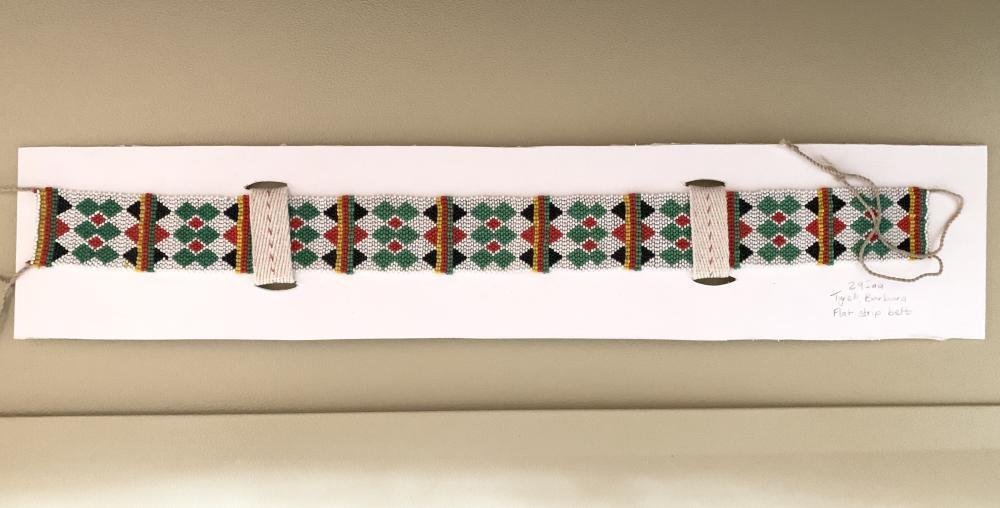Flat Strip Belt
| CCAC #: | 0295aa |
| Artwork title: | Flat Strip Belt |
| Artist(s): | Unknown |
| Year made: | Unknown |
| Artwork type: | Sculpture or object |
| Medium: | Glass beads and cotton thread and string. |
| Dimensions (mm): | 500 x 20 |
| Artwork collections: |
Barbara Tyrrell beadwork collection |
| Source: | Donated by Barbara Tyrrell |
| Year acquired: | 2009 |
| Installation type: | Movable artwork |
| Current location: | In storage |
| Signage: | Southern African beadwork Donated by Barbara Tyrrell in 2008 In 2008, Barbara Tyrrell donated 118 pieces of beadwork to the CCAC. Tyrrell collected the beadwork from those who sat for portraits drawn by her. Some of the beadworks were bought, and others were given to her as a token of generosity and friendship. In her book titled Tribal People of Southern Africa (first published 1968), Tyrrell describes and studies the dress code of 25 groups within three main ethnic groups of the Southern African people (including present-day Zimbabwe). The three groups are namely: Sotho/Tswana of Botswana, Nguni, and Tsonga of the Drakensberg and Zulu, Swazi and Xhosa people of Natal. Each tribe differs in the language spoken, dress, and custom. Often, the tribes were named after the surname of their first chief. Under the main chief would be a series of lesser chiefs, each in charge of a group of families who then constituted a clan. The law of the tribe is based on custom, culture, and traditions that determine the tribe’s manners, beliefs, and ethics. According to Tyrrell, beadwork played an important role in each tribe's belief systems, yet much of what the people wore during the time of drawing has changed or disappeared. Among the Ndebele, the disappearance of traditional wear has been slow but sure. A more drastic change in fashion was seen among the Zulu people since Tyrrell’s first journey in Zululand, now known as KwaZulu-Natal. Traditional daily wear has been replaced with common clothes. Women’s tall head-dresses indicating marital status and tribal dresses are now worn only for special occasions, while men mostly wear their beaded ornaments on top of European clothing during celebrations. This is also relevant amongst the Basotho, who had already adopted European styles in 1948. This gave rise to the introduction of the Basotho blanket by a foreign trader. According to Tyrrell, tribes such as the Venda, Swazi, and Xhosa have managed to maintain more of their tribal ways of dressing. Tyrrell highlights that European clothing styles played an important role in the “tribal” people’s conversion to Christianity and during the nineteenth century. “Tribal” people started considering European fashion as being synonymous with being Christian, while tribal dress and beadwork became considered as “heathen”. Beadwork use has also morphed to become part of a mixed African-European fashion sense. In 2019, some of the CCAC beadwork was sent to beadwork specialist Hlengiwe Dube who was able to supplement Tyrrell’s notes, adding how some of the beaded items are still attached to certain African beliefs for restoration and preservation of cultural documentation. |

Photographer: Staff
Photo copyright: CCT
NOTE: The process of photographing artworks in the CCAC is underway - we are currently working to improve image quality and display on the CMS but have included internal reference photos for identification purposes in the interim.